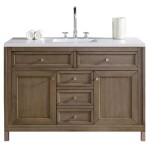Can You Paint a Bathroom Sink: A Comprehensive Guide
Painting a bathroom sink can be a cost-effective and relatively straightforward method for updating the aesthetics of a bathroom without undertaking a full replacement. This process is particularly appealing when dealing with outdated colors, minor surface imperfections, or simply a desire for a fresh look. However, the longevity and success of a painted bathroom sink hinge on careful preparation, the selection of appropriate materials, and the adherence to proper application techniques. This article provides a detailed guide on whether you can paint a bathroom sink, the essential steps involved, and the factors to consider for optimal results.
Before embarking on a painting project, it's crucial to assess the sink's material. Bathroom sinks are commonly constructed from various materials, including porcelain, ceramic, cast iron, acrylic, and stainless steel. Each material reacts differently to paint, and the chosen paint and primer must be compatible with the sink's specific composition. Identifying the sink's material is the first step in determining the feasibility and the appropriate methodology for painting.
Understanding Sink Materials and Paint Compatibility
Porcelain and ceramic sinks are among the most common types found in bathrooms. These materials are hard, non-porous, and typically coated with a glossy glaze. Painting porcelain or ceramic requires specialized epoxy-based paints designed to adhere to these smooth surfaces. Standard paints are unlikely to bond effectively and will peel or chip over time. Proper surface preparation, including thorough cleaning and etching, is also vital to promote adhesion.
Cast iron sinks are often coated with porcelain enamel, which presents similar challenges to painting regular porcelain or ceramic. The enamel surface needs thorough preparation to ensure the paint can properly grip. Rust can be an issue with older cast iron sinks, and addressing this before painting is critical for preventing future problems.
Acrylic sinks, on the other hand, are generally easier to paint than porcelain or ceramic. Acrylic is a more porous material, which allows for better paint adhesion. However, it is still essential to use a primer specifically designed for plastic surfaces to ensure a durable finish. Avoid using harsh chemicals during the cleaning process, as these can damage the acrylic surface.
Stainless steel sinks can be painted, but the process is more complex. Stainless steel is a non-porous material, and specialized primers and paints designed for metal are necessary to achieve a successful and lasting finish. The surface must be meticulously cleaned and etched to create a suitable bonding surface for the paint.
Regardless of the sink material, understanding its properties and selecting compatible paints and primers are paramount to achieving a successful painting outcome. Consulting with paint specialists at a local hardware store can provide valuable insights and recommendations for specific materials and products that will work best for the project.
Essential Steps for Painting a Bathroom Sink
The painting process itself involves several crucial steps, each contributing to the overall outcome. These steps include preparation, priming, painting, and sealing. Skipping or inadequately performing any of these steps can compromise the final result, leading to premature chipping, peeling, or discoloration.
1. Preparation: Thorough cleaning is the first and arguably the most important step. Remove all soap scum, mineral deposits, and grime using a strong cleaner. A combination of dish soap, baking soda, and vinegar can be effective for tackling stubborn stains. Rinse the sink thoroughly with clean water and allow it to dry completely. Following the cleaning, use sandpaper to create a roughened surface. This process, known as etching, provides a better grip for the primer and paint. Use progressively finer grits of sandpaper, starting with a coarser grit (e.g., 120 grit) to remove the shine and ending with a finer grit (e.g., 220 grit) to smooth out the surface. Wipe away all sanding dust with a tack cloth to ensure a clean surface for priming.
2. Priming: Applying a primer is essential for creating a bonding layer between the sink surface and the topcoat of paint. Choose a primer specifically designed for the sink's material. Epoxy primers are often recommended for porcelain and ceramic, while plastic primers are suitable for acrylic sinks. Apply the primer in thin, even coats, following the manufacturer's instructions regarding drying time. Multiple thin coats are preferable to a single thick coat, as they minimize the risk of drips and ensure a more even application. Allow the primer to dry completely before proceeding to the painting stage.
3. Painting: Select a high-quality epoxy-based paint designed for bathroom use. These paints are specifically formulated to withstand moisture and frequent cleaning. Apply the paint in thin, even coats, using a brush, roller, or spray gun, depending on the paint type and manufacturer's recommendations. Again, multiple thin coats are better than one thick coat. Allow each coat to dry completely before applying the next. Lightly sand between coats with fine-grit sandpaper (e.g., 400 grit) to remove any imperfections and create a smoother surface. This step helps to ensure a professional-looking finish.
4. Sealing: Applying a sealant or clear coat can provide extra protection and durability to the painted surface. Choose a sealant compatible with the paint type used. Apply the sealant in thin, even coats, following the manufacturer's instructions. Allow the sealant to dry completely before using the sink. Avoid harsh cleaning products or abrasive scrubbers during the first few weeks after painting to allow the paint and sealant to fully cure.
Factors Affecting the Durability of Painted Bathroom Sinks
The durability of a painted bathroom sink depends on several factors, including the quality of the materials used, the thoroughness of the preparation, and the level of use the sink receives. High-traffic bathrooms and sinks subjected to frequent scrubbing or harsh chemicals are more likely to show wear and tear over time.
The quality of the paint and primer plays a significant role in the longevity of the painted finish. Investing in high-quality epoxy-based paints specifically designed for bathroom environments is crucial. These paints are more resistant to moisture, stains, and chipping. Cheaper paints may be tempting, but they are likely to degrade more quickly, requiring frequent touch-ups or repainting.
Proper surface preparation is equally important. Inadequate cleaning or sanding can result in poor adhesion, leading to premature peeling or chipping. Taking the time to thoroughly clean and etch the sink surface is essential for creating a strong bond between the paint and the underlying material.
The level of use the sink receives also affects its durability. Sinks in high-traffic bathrooms are more likely to experience wear and tear from frequent use and cleaning. Using gentle cleaning products and avoiding abrasive scrubbers can help to prolong the life of the painted finish.
Furthermore, the presence of existing damage to the sink can impact the durability of the painted surface. Cracks, chips, or rust should be repaired before painting. Filling cracks with epoxy filler and sanding them smooth can create a more even surface for painting. Addressing rust with a rust converter can prevent it from spreading and compromising the paint job.
Finally, proper curing time is essential for the paint to fully harden and adhere to the surface. Allowing the paint and sealant to dry for the recommended period, typically several days, before exposing the sink to water or cleaning products is crucial for achieving a durable and long-lasting finish.
In conclusion, painting a bathroom sink is a viable option for updating its appearance, provided that the correct materials and techniques are employed. Success hinges on thorough preparation, careful selection of compatible paints and primers, and adherence to recommended application and curing procedures. While painting offers a cost-effective alternative to replacement, maintaining the painted surface and addressing any damage promptly are key to preserving its longevity and aesthetic appeal.

How To Paint A Sink It All Started With

How To Paint A Sink It All Started With

Paint Bathroom Vanity Countertop Sink So Easy A Piece Of Rainbow

How To Paint A Sink Diy Bathroom Project Your Budget Will Love

Transform Your Bathroom With Sink Paint The Honeycomb Home

How To Paint A Sink Diy Bathroom Project Your Budget Will Love

How To Easily Spray Paint Bathroom Countertops My Homier Home

How To Paint A Sink It All Started With

Transform Your Bathroom With Sink Paint The Honeycomb Home

Can You Paint A Bathroom Sink Yes And Here S How Badeloft







